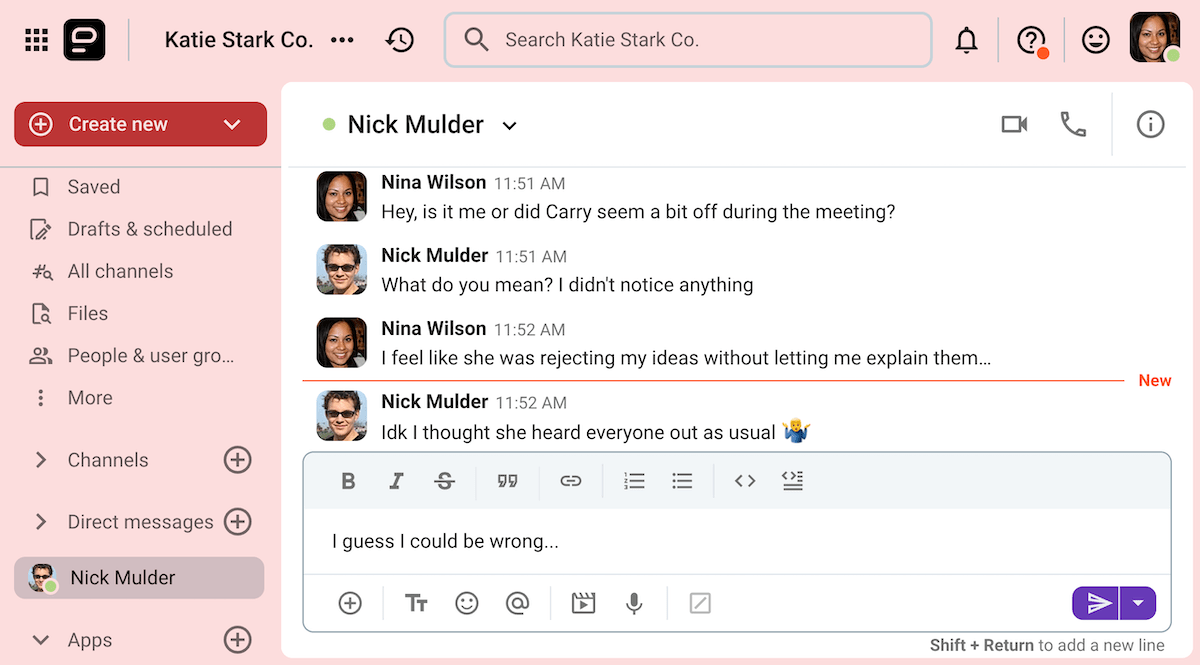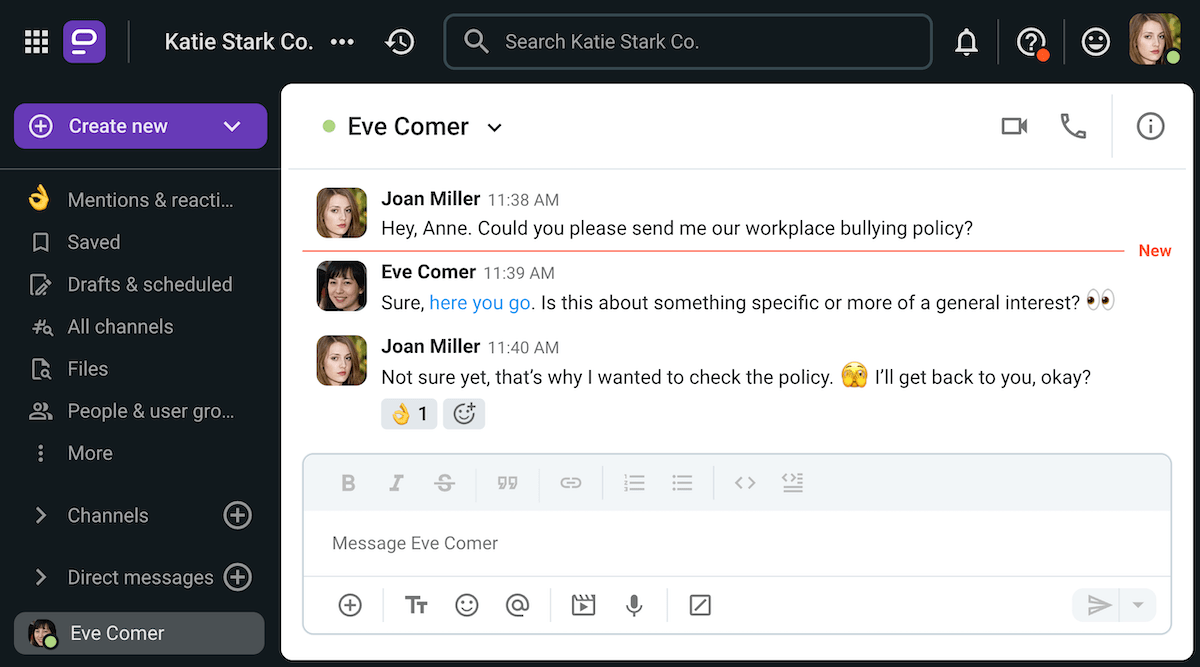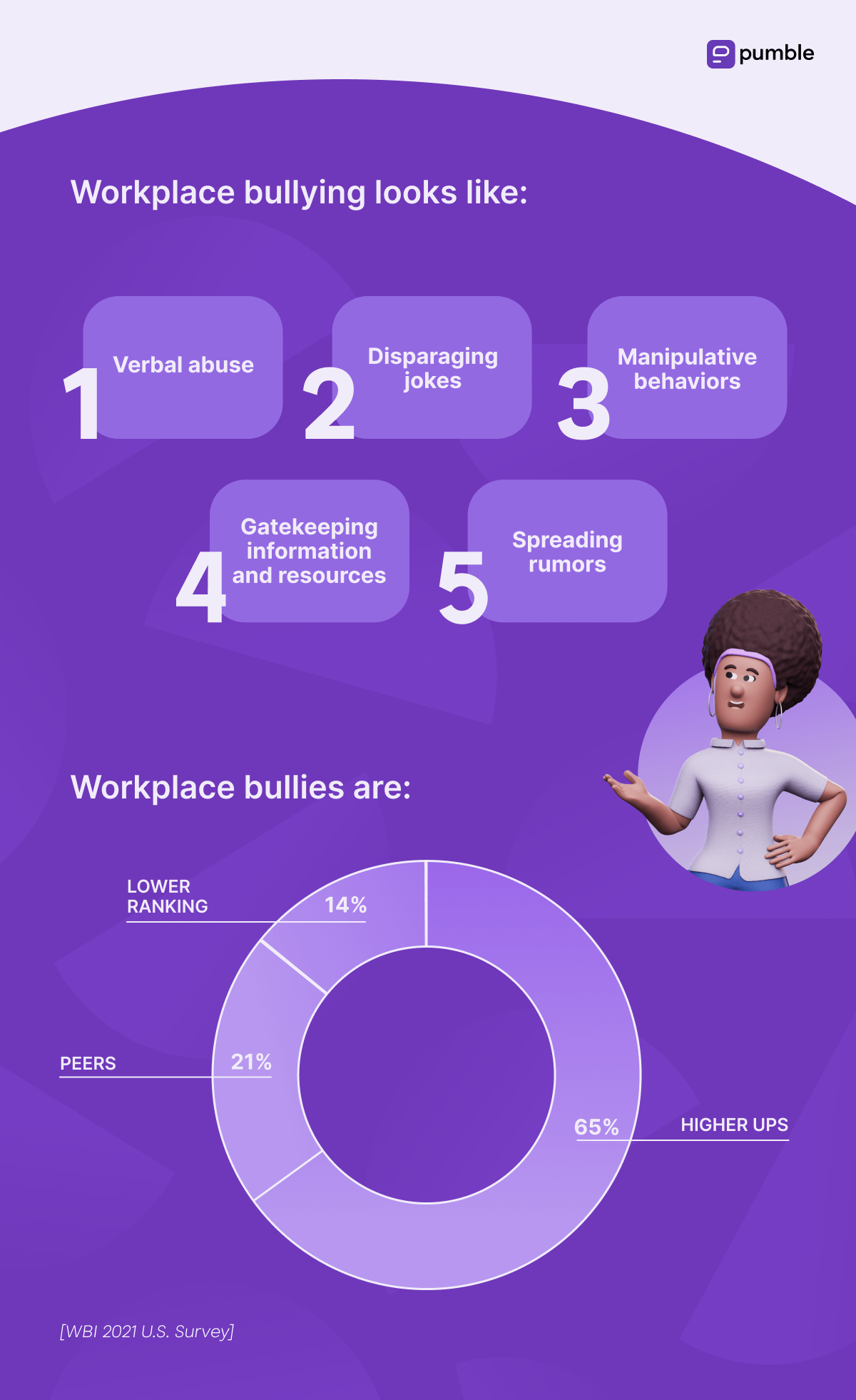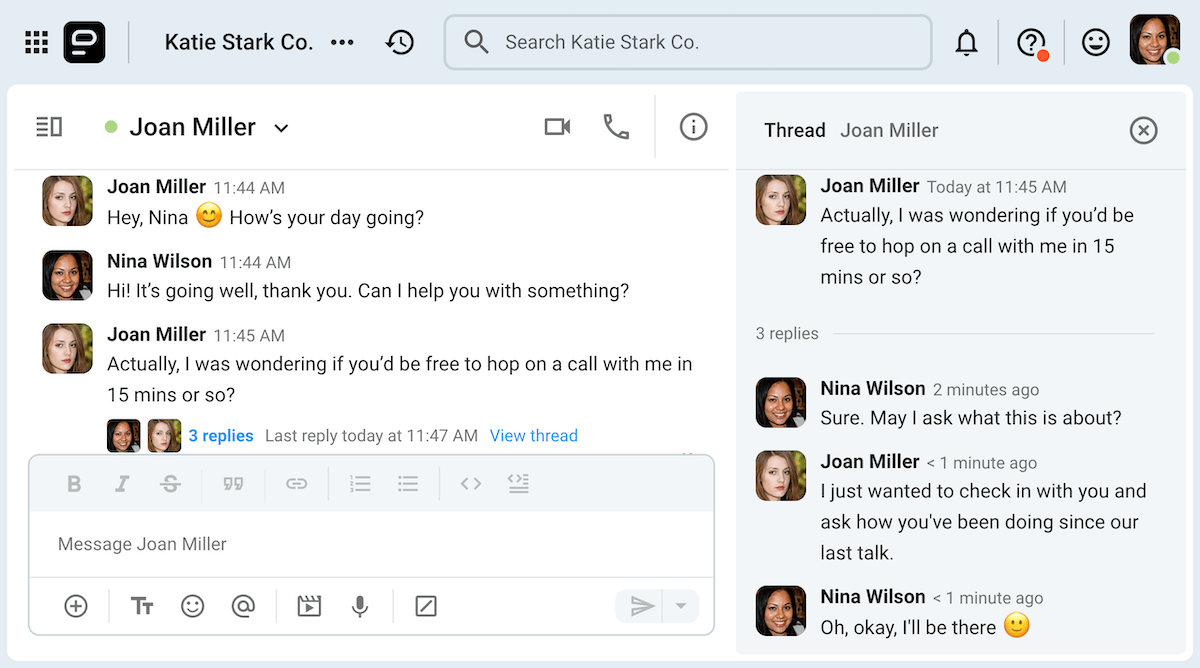What comes to mind when you’re asked to imagine a bully?
Perhaps distant memories of schoolyard tyrants whose only goal was to strike fear into the hearts of their classmates?
Yet, for those who have had the misfortune of realizing that some bullies stay bullies well into adulthood, this question may conjure the image of a manager or even a close coworker.
According to the latest survey, 30% of US adults have directly experienced workplace bullying. And, lest you think that this kind of behavior is only common among in-office workers, that number rises to 43.2% for those working remotely.
Because of these worrying statistics, many organizations have had to reexamine the way they approach workplace harassment.
However, if your company hasn’t quite gotten around to doing so — or if your efforts to enforce an anti-bullying policy haven’t taken root yet — here’s how you can handle bullying in the workplace as a manager.

Tip #1: Understand the consequences of toxic workplace culture
Generally speaking, few organizations feel the need to deal with difficult employees as long as their behavior doesn’t cross the bounds of legality.
Acknowledging workplace bullying before that point would mean admitting that there’s something wrong with the company culture, since employee misconduct is often seen as the reflection of management.
After all, a manager would have had to onboard the bully in question and miss the signs of toxic work culture for quite some time before the issue became apparent.
But, if you yourself are a manager, you need to look beyond the stigma and really consider the effect this behavior might have on team performance and dynamics.
According to the author of Inclusive Leadership for Dummies, Dr. Shirley Davis, letting toxic behavior slide might affect employee trust as well as a company’s reputation:

“When the team sees these behaviors, they too feel uncomfortable and unsafe to speak up. Thus, the company loses out on getting the best ideas and being more innovative in solving business problems. What’s more, it loses great talent. Additionally, the company’s reputation suffers internally and externally because staff does talk amongst themselves and they will take to social media, employee surveys, and external reporting sites to share their feedback.”
Furthermore, according to Dr. Jason Walker, an Associate Professor of Industrial-Organizational and Applied Psychology, workplace bullying can have many detrimental effects both on the team in general and the individual experiencing it:

“Workplace bullying severely impacts morale and productivity. Long-term effects include:
- Increased absenteeism,
- High turnover, and
- Diminished team dynamics.
All of this reduces workplace efficiency and cohesion. Targets often suffer from mental and physical health issues, including hypertension, cardiovascular disease, anxiety, depression, PTSD, and, in extreme cases, suicide.”
Tip #2: Learn how to recognize workplace bullying
Once you’ve understood the potential risks of ignoring workplace bullying, you may find yourself wondering how you might recognize it on your own team.
After all, this isn’t the schoolyard we’re talking about — workplace bullying tends to be much more subtle.
Though some bullies do verbally abuse their coworkers, most are still afraid of being outright hostile in the workplace, instead opting to:
- Ridicule people with disparaging jokes or microaggressions,
- Manipulate others (into doing work that’s not theirs),
- Withhold important information or resources, and
- Practice subtle duplicity (for example, by spreading rumors).
According to Dr. Walker, there are other signs that might point to bullying in remote work environments:

“In remote settings, managers should watch for signs like:
- Unproductive group dynamics,
- Exclusion in virtual meetings, or
- Increased colleague complaints about communication issues.
A toxic employee may dominate discussions or make subtle, harmful, or derogatory remarks. Emails can often be an avenue to belittle and harass people because the perpetrator can hide behind the virtual screen. Identifying these overt and covert types of bullying is essential to understanding what is happening and for management to deal with it.”
Even so, based on the aforementioned, recent survey from the Workplace Bullying Institute, bullying in remote work settings doesn’t happen in all communication situations.
For example, even though 15% of respondents have experienced bullying in private online meetings, a larger percentage (35%) of people claim to have experienced it during group conference calls. Indeed, 70% of survey respondents claim that the online mistreatment they experienced happened in front of other people.
Yet, even though most of this abuse is public, people may not wish to speak out against it — as shown in the following interaction on the team communication app, Pumble.

Reach out to your coworkers on Pumble
Tip #3: Check the company policy on workplace bullying and harassment
If you’ve only recently become a manager, you probably haven’t had to participate in conflict resolution between team members before.
In fact, you may not even be familiar with your company’s official policy when it comes to workplace bullying.
So, before you attempt to work out who’s in the wrong, you may want to start by reading that document.
If the policy isn’t as clear as it ought to be, consider reaching out to an HR employee through your workplace communication app.
Remember, you don’t have to name names during that first conversation. You could always take the time to really suss out who’s in the wrong before officially looping HR in.
Below is one example of what that initial conversation might look like on Pumble.

Share files easily over Pumble
Tip #4: Consider the usual suspects
Once you know which behaviors are officially prohibited by the company policy, you’ll be better equipped to examine the situation in your team.
Ideally, you should be able to spot the instigator of the toxic behavior without an issue.
But, what if the situation is not as clear cut as you’d like it to be?
In that case, it might help to know some statistics on the most likely perpetrators of abuse in the workplace.
According to the Workplace Bullying Institute, most bullies target those below them in the company hierarchy, with:
- 65% of workplace bullies targeting subordinates,
- 21% of bullies targeting their peers, and only
- 14% of workplace bullies targeting their superiors.
If you’re trying to determine whether someone on your team is a bully, it might also be helpful to consider the industry you work in, as some have a greater instance of toxic behaviors than others.
For example, according to a report on Toxic Work Culture in Tech Companies, 40% of employees in tech companies report frequent bullying and harassment — which is certainly a higher number than the average we’ve previously mentioned.
The same report also noted that tech workers were split when asked who’s responsible for the toxic culture in their company, with:
- 20% claiming it was leadership and senior management,
- 18% blaming middle management,
- 17% pointing the finger at their direct manager,
- 16% blaming colleagues from other teams,
- 15% blaming colleagues in their own teams, and
- 14% blaming HR.
So, if you’re unable to pinpoint who’s bringing the energy down, try examining one of these factions. Just keep in mind that not every instance of workplace bullying will neatly follow these statistics.

Tip #5: Collect the evidence
Once you’ve found the source of the conflict on your team, you’ll want to start documenting each instance of abuse — even if your ultimate goal is to make everyone get along.
According to Dr. Walker, you should begin by trying to understand the scope of the situation:

“Managers should address bullying promptly by first seeking to understand, while:
- Documenting behaviors,
- Involving HR, and
- Having open discussions with the parties involved.”
Of course, this tip should be equally useful to those who have been the targets of workplace bullying, as Dr. Walker noted:

“Targeted individuals must be aware of what is happening to them and have the courage to speak up calmly to the perpetrator (providing them space to correct the behavior) or to elevate the issue if they don’t.
Be sure to talk with others around you and ask them to pay attention when the perpetrator is present regarding what is said and the behaviors that occur.
Also, start documenting what’s happening in a private journal you take home with you, such as the time, date, place, who was there, what was said, and how it impacted you. Identifying the patterns will help if there is an investigation.”
However, since almost half (49%) of the employees surveyed for the Toxic Work Culture in Tech Companies report say that they wouldn’t do or say anything when faced with toxic behaviors at work, getting to the bottom of this issue may be up to leadership and management.
💡 PUMBLE PRO TIP
If you want to be able to handle workplace bullying discreetly but effectively, you may want to brush up on your communication skills — such as active listening. These resources might help with that:
Tip #6: Try to correct the behavior
In the interest of being fair, you may feel compelled to give everyone involved in the bullying incident you’ve discovered a chance to correct their behavior.
After all, in many workplace bullying cases, the main perpetrators are found to be people who otherwise bring great value to the company — i.e. extremely talented or experienced top performers.
In that case, it may be helpful to arrange private one-on-one meetingswith everyone involved, as recommended by the mental health expert and author of The Resilience Plan, Dr. Marie-Hélène Pelletier:

“Have a conversation with all parties involved separately, reminding them of workplace policies and expectations; then consider bringing in training to increase everyone’s understanding of healthy workplace behaviors.”
Hold all your meetings over Pumble
After your initial meeting with the offenders, you should continue to check in on them to see if your efforts have been successful.
If their behavior doesn’t improve in a significant way, Dr. Pelletier recommends providing educational opportunities — which is what employees seem to want, too.
According to the Toxic Work Culture in Tech Companies report, 48% of employees believe that workplace training can help in fostering a more positive and healthy work environment.
💡 PUMBLE PRO TIP
If your quest to curb bullying on your team sparks more conflict, here are some phrases you can use to get everyone to simmer down:
Tip #7: Offer your support to the victimized employees
While you’re dealing with workplace bullies, it’s important not to neglect the employees who have been targeted by their harassment.
In fact, you should ideally offer your support to the targets of the harassment you’ve noticed even before you speak with the bullies.
As Dr. Jason Walker told us, employers should practice empathetic communication and validate the victim’s experiences:

“Empathy and validation are essential when supporting bullied employees. Employers should provide resources like counseling and clarify that the organization has policies to address such behavior, following up to ensure recovery and workplace harmony.”
In other words, you’ll need to re-establish psychological safety on your team by:
- Making sure the target of workplace bullying is included in team activities,
- Offering them advice or words of encouragement, or perhaps
- Sharing a coffee with them once in a while (even virtually).
These small gestures can help people who have been the victims of targeted harassment regain a sense of normalcy after going through a harrowing period.

Check in with your coworkers over Pumble
Tip #8: Implement disciplinary measures
If, despite your best efforts, the bullying persists, you should feel no remorse in escalating the situation and getting HR involved.
Use the evidence you have compiled by this point to create an official paper trail of the perpetrators’ misconduct. In other words, just write them up.
As Jamie Woolf, a workplace culture and employee development expert with a background in organizational psychology, put it, strictly enforcing your anti-bullying policy is a great way to make it clear that no one is untouchable:

“Put systems in place where people can report issues safely, and then actually follow through with real consequences. Show, don’t just tell, that your organization doesn’t tolerate bad behavior. When employees see you hold people accountable, they’ll trust the culture you’re building is real — not just lip service.”
So, if your initial warnings are ignored, be sure to follow through with the consequences that are outlined in your company policy.
💡 PUMBLE PRO TIP
Initiating a disciplinary action against an employee may affect others on your team in both positive and negative ways — particularly if the employee in question is a higher up in the company. To address any concerns that may arise due to this decision, take a page out of the crisis management book and come up with a crisis communication plan:
Tip #9: Consider the role the corporate culture plays in enabling toxic behavior
As we have established, organizations are often slow to react to workplace bullying, partly because knowing that there are bullies in their midst can be seen as a reflection of their corporate values, and partly because those bullies are often people who are high on the corporate ladder.
However, if your goal is to completely root out this toxic behavior at your company, you have to consider whether your company culture is encouraging bullying, as Dr. Walker noted:

“A culture that tolerates toxic behaviors indirectly encourages bullying. When transparency, accountability, and open communication are central to an organization’s culture, these harmful behaviors are less likely to take root.”
Creating a culture that encourages accountability can be done by taking a tough stance against bullying and making sure employees are aware of the consequences of such behavior through regular training on workplace harassment as well as periodic reviews of team dynamics.
On top of that, you need to make sure that your company’s leadership is taking charge on this issue, as Jamie Woolf advises:

“Accountability starts at the top. Managers, leaders, and HR pros need to model the behavior they want to see — no exceptions. If you say you’re committed to respect and inclusion, then back it up by taking action — swiftly and decisively — when toxic behaviors surface.”
💡 PUMBLE PRO TIP
Workplace bullying is much less likely to take root in positive work environments. But, how would you know if that’s what you have in your company? Check out this article to find out:
Tip #10: Adjust your hiring practices to avoid hiring bullies in the first place
As a bonus tip, let’s talk about another way to prevent bullying in the workplace — not hiring bullies in the first place.
According to Jamie Woolf, there are 3 potential ways to pick those bullies out of your pool of candidates:

“1. Look beyond the résumé and qualifications. Skills matter, but so does character. Use behavioral interview questions that dig into how candidates handle conflict, work in teams, and respond to feedback.
2. Prioritize reference checks. Ask former colleagues and managers specific questions about how the candidate treated others. Were they collaborative? Did they foster a positive environment? Were there any red flags in how they led teams or managed stress?
3. Get your team involved. Group interviews can reveal how someone interacts with future coworkers. If they interrupt, dismiss ideas, or dominate conversations, that’s a signal to pay attention to.”
Dr. Walker also noted the benefits of using behavior-based questions during job interviews:

“Watching for red flags, like candidates who speak negatively about previous coworkers, can help identify potential bullies during interviews. Ask them how they would manage a bully in the workplace and pay attention to whether they demonstrate empathy or if they dismiss the issue altogether.”
Ultimately, picking these red flags out of your pool of job candidates should help you lower your chances of encountering workplace bullying in the future.
Banish workplace bullying with Pumble
If left unaddressed, even seemingly benign incidents of workplace bullying can escalate into major issues for the company.
Small jokes at a coworker’s expense turn into malicious rumors and gaslighting, and, before you know it, you’re stuck with a company that’s bleeding talent left and right.
After all, it’s difficult to practice teamwork and collaboration, let alone team communication, in toxic environments.
So, what’s a leader to do?
Well, one way to ensure the happiness of your team would be to follow the advice we have laid out above, even if you haven’t found bullying incidents on your team yet.
Namely, you can always strengthen your company’s anti-bullying policy and provide ongoing employee education about the consequences of workplace harassment.
Furthermore, you can make sure that your team has a secure messaging app they can use to keep track of their internal communication.
The business communication app, Pumble, is the perfect tool for any organization looking to keep employee conversations on the record.
After all, the app boasts an unlimited message history, which targets of workplace bullying can use to establish a paper trail of abuse.
On top of that, Pumble also offers all the standard messenger features, from DMs, channels, and threads to video calls and more — all at an incredibly affordable price.
Keep your team communication above board — try Pumble today.







